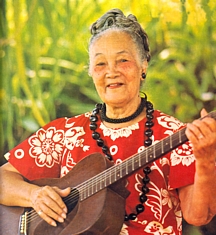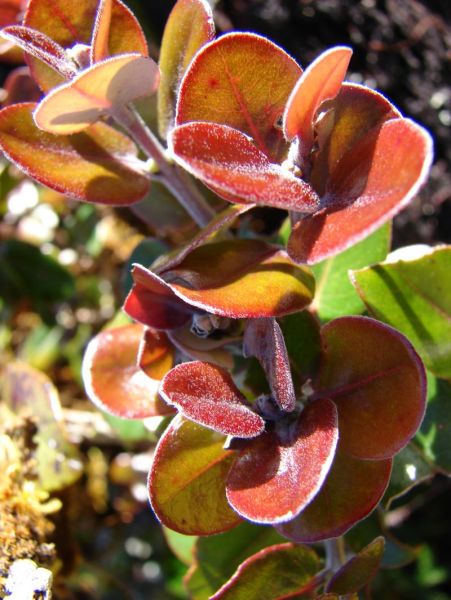Digital Collections
Celebrating the breadth and depth of Hawaiian knowledge. Amplifying Pacific voices of resiliency and hope. Recording the wisdom of past and present to help shape our future.
Kīhei de Silva
Haku mele: A young Kohala man of the late 19th century.
Source: Alice K. Namakelua, Auntie Alice Namakelua, Hula HS-557.
Discography: 1) Auntie Alice Namakelua, Hula HS-557. 2) Dennis Pavao, All Hawai‘i Stand Together, Poki SPC-9055 (1994).
Text below: As given and translated on Auntie Alice Namakelua, Hula HS-557.
‘Auhea wale ‘oe e ka manu
Ku‘u hoa ‘alo leo o ka pō anu
Mea ‘ole ia anu a i ka mana‘o
Ke koi‘i koi mau a ka pu‘uwai
Na wai nō ‘oe e pakele aku
Ua like me ka liko a‘o ka lehua
Ka maka o ka lehua ka mea aloha
Ka wehi holu mai ma ka hikina
E honi kāua e ke aloha
Ke noe mai nei ka pua lehua
Alia ‘oe a e pūlale mai
A hala o maile lau kapalili
He lili ka mana‘o o ke kapena
Nā ‘ale pō‘ipu a‘o ka moana
Ua ana pono ‘ia ko‘u mana‘o
E ka lei hulu nani hulu melemele
He mele kaulana no Nihoa
Ua hui Kāne‘ohe me Pohoiki
Ha‘ina ‘ia mai ana ka puana
Good-bye kāua me ka ‘eha‘eha.
Listen, O bird,
My companion of the cold night’s gossip
This cold is nothing to my mind;
The heart’s desire is ever urgent
Who could escape you
You are like the leaf-bud of the lehua
The eye of the lehua is what I love
The adornment that sways to the coming
Let’s kiss, love
The lehua flower is misting
Don’t rush me
When the maile’s leaves are trembling
Jealous is the mind of the captain
Engulfing are the waves of the ocean
My mind is made up
O lei of beautiful feathers, golden feathers
Nihoa’s song is famous:
Joined were Kāne‘ohe and Pohoiki
The story is told:
We say good-bye with great pain.
When Alice Namakelua (b.1892 in Honoka‘a, Hawai‘i) was only a girl, she learned this song from an older Kohala man who, in his youth, had fallen in love with a Hilo girl. The girl’s parents did not want her involved with anyone who lived so far from Hilo, so they forced her to end the relationship. The boy composed this song as an expression of the depth of his love and the heartbreak of their parting (verses six and seven are said to be her words, the rest are his own); he shared his composition with Aunty Alice some thirty years after that parting. According to Aunty Alice, neither the Kohala boy nor the Hilo girl ever married; they remained single all their lives.
"Ka Manu" offers considerable insight into Hawaiian folk compositions of the second half of the 19th century. It is not a mele of the royal court—it is neither for nor by the ali‘i—yet it has the perspective, resonance, and grace of expression that characterize the best poetry of the period, royal or otherwise. Its beauty suggests that the distinction sometimes made between the high and low poetry of court verses country is less than accurate. It suggests, as well, that Hawaiian composers of both high and low station shared similar poetic values. I feel, then, that the following observations about the poetry of "Ka Manu" are representative of this larger body of Hawaiian composition.
Like the authors of countless other old Hawaiian songs catalogued in today’s song collections as "traditional," the author of "Ka Manu" is not a big-name writer; indeed, he is an unnamed young man. Though influenced by western styles of composition, Hawaiian poetry of his century (and much of ours), had not taken on western notions of property and personality. Poets did not own their poetry; in fact, a mele was meant to be the possession, like a feather lei or other cherished adornment, of the person it honored. The haku mele only stepped forward to give his poem away, then he promptly stepped back into anonymity. Consequently, the image of the poet as a breed apart—as a gifted, uniquely suffering and sensitive, self-immortalizing genius—is largely absent from late 19th century Hawaiian composition. Consequently, the presence of an author’s creative ego in a mele—as Walt Whitman, for example, is unmistakably present in his poetry—is again largely foreign to Hawaiian composition of the period. The late 19th century Hawaiian poet was neither intimidated by concepts of a poet’s rarified talents nor concerned with making a big name for himself. The Hawaiian poet was Everyman; it was a natural thing for him—ali‘i or maka‘āinana, known or unknown, young or old—to express his deepest thoughts and strongest emotions in mele. To expand on one of Keali‘i Reichel’s favorite similes, we can say that the practice of composition, like that of oli, was then "as common as humming."
Despite its sorrowful context, "Ka Manu" emphasizes beauty and joy. Although the song is obviously inspired by heartbreak, the language of pō anu, lili, and good-bye kāua me ka ‘eha‘eha—gossip, jealousy, and pain—takes up only three verses of the 10 verse piece. The remainder of the song is concerned with the wonders of young love: with attraction, desire, and union. The pain is huge (and even more poignant because it is not paraded all over the mele), but the focus is on that which nourishes the soul rather than eats away at it. There is no Romeo and Juliet outcome, no tragic double suicide, to the story of the Hilo girl and Kohala man; they endure. Mele of this age are the work of survivors, of those who refuse to give in to despair and self-pity. Their poetry is characterized by this refusal; it is evident in as "high" a song as "Kaulana nā Pua" and in as "low" a song as "Ka Manu."
The author of "Ka Manu" assembles his song with a beautiful selection of phrases, most of which would have had a familiar ring to his listeners. His opening "‘Auhea wale ‘oe" is the opening line of innumerable mele; "‘alo leo i ka pō anu" is a favorite expression for someone in the uncomfortable position of dodging or enduring gossip; "na wai nō ‘oe e pakele aku" is a standard expression for irresistible beauty. The images of love and lovers—liko lehua, maka lehua, noe lehua, lau kapalili—are exactly the images that a Hawaiian audience would recognize and delight in. This process of selection and arrangement is, in fact, what the haku of haku mele means. The Hawaiian poet’s craft, like the lei maker’s craft, is that of arranging carefully chosen flowers in a most pleasing, effective, and appropriate manner. The poet does not attempt to compose in a vacuum; he is not driven to write what has never been written; singularity is not the big yardstick by which he measures his effort. Evidence of obsessive creativity, ownership, and ego is largely absent from Hawaiian poetry of two centuries past. Instead, late 19th and early 20th century haku mele love to use and re-use each other’s language. Such recycling shows the interconnectedness of people, thought, and emotion; it establishes the all-important sense in Hawaiian poetry of foundation and continuity; it demonstrates an additional Hawaiian poetic ideal: that of cultural literacy—of knowledge of other mele, proverbs, and poetic expressions.
Creativity, however, is not absent from mele of the period; new or unexpected language is often used to accent a poem’s otherwise traditional flavor and to startle us into under-standing and insight. In "Ka Manu," the sudden appearance of three place names—Nihoa, Kāne‘ohe, and Pohoiki—in the ninth verse of a song whose previous 16 lines are devoid of place names makes for a meaning-packed and incisive summary of the love that the couple has shared. He is "bamboo man," she is "small depression," their union is "firmly locked." "Aha!" we say, "this is not puppy love; they have intimate knowledge of each other." The same kind of zinger is evident in the last line of the song when the English "Good-bye" comes out of nowhere to hammer home the pain of their parting. "Aha!" we say, "it is as if that pain is so unfair, so foreign to love, that it can’t be expressed in the poet’s mother tongue." This is creative stuff—as is the flower vase of "Ka Nani a‘o Hilo," the standing mirror of "Ka Ua a‘o Hilo," the thin, magnetic, Mexican banana of "Piukeona," and the whirring propeller of "Māhukona"—but creativity’s purpose is always to frost an already well-established, traditional cake.
Finally, the haku mele of "Ka Manu" constantly transforms the human into the natural. He describes the girl he loves as his lehua leaf bud and his lei of beautiful bird feathers. He describes their physical and emotional love for each other as a swaying lehua blossom, a misting lehua flower, a trembling maile leaf, and the joining of Kāne‘ohe and Pohoiki in a bond that is Nihoa. He even transforms the forces of parental disapproval into an image of the engulfing waves of the deep ocean. Transformation of this sort is an essential feature of Hawaiian poetry of the period; one could not expect to compose in a traditional Hawaiian manner without transforming people and their emotions into flowers, birds, winds, waves, cliffs, place-names, and (as western contact put us in touch with a flood of interesting objects) vases, row boats, propellers, and sugar-boilers. The converse is true as well: one could not expect to compose Hawaiian mele without infusing the natural and object worlds with humanity. Aunty Alice Namakelua’s "Aloha Ko‘olau," for example, was inspired by a car ride over Nu‘uanu Pali. The song is a simple celebration of the beauty of the mists, rains, and waterfalls that she sees along the way, but there is no mistaking her Hawaiian viewpoint: the sky is a man; the land is a woman; the mist-rain-waterfall is their joyous union; life is the result.
These transformations are more than poetic techniques, more than metaphor and personification. They reflect a fundamental Hawaiian belief in the unity of me and not-me, self and other, this and that. The traditional haku mele’s sense of unity explains his lack of interest in self-promotion, his eye for beauty, and his love of foundation and continuity. His devotion to humility, grace, and depth is one that Hawaiian poets of today would do well to follow.
© Kīhei de Silva 2006
The essay above was written by Kīhei de Silva and published in his book He Aloha Moku o Keawe: A Collection of Songs for Hawai‘i, Island of Keawe, Honolulu, 1997, pps. 56–59. It is offered here, in slightly revised and updated form, with his express consent. He retains all rights to this essay; no part of it may be used or reproduced without his written permission.

photo credit: Hula Records
Alice Ku‘uleialohapoina‘ole Namakelua, 1974. Aunty Alice learned "Ka Manu" from a Kohala man who, in his youth, was forced to break off his relationship with a Hilo girl whose parents did not want their daughter involved with anyone who lived so far away. This song describes the couple’s painful parting, their "goodbye kāua me ka ‘eha‘eha."

photo credit: Forest & Kim Starr
Liko lehua, lehua leaf buds, vary in color. Some grow with a red or pink hue.